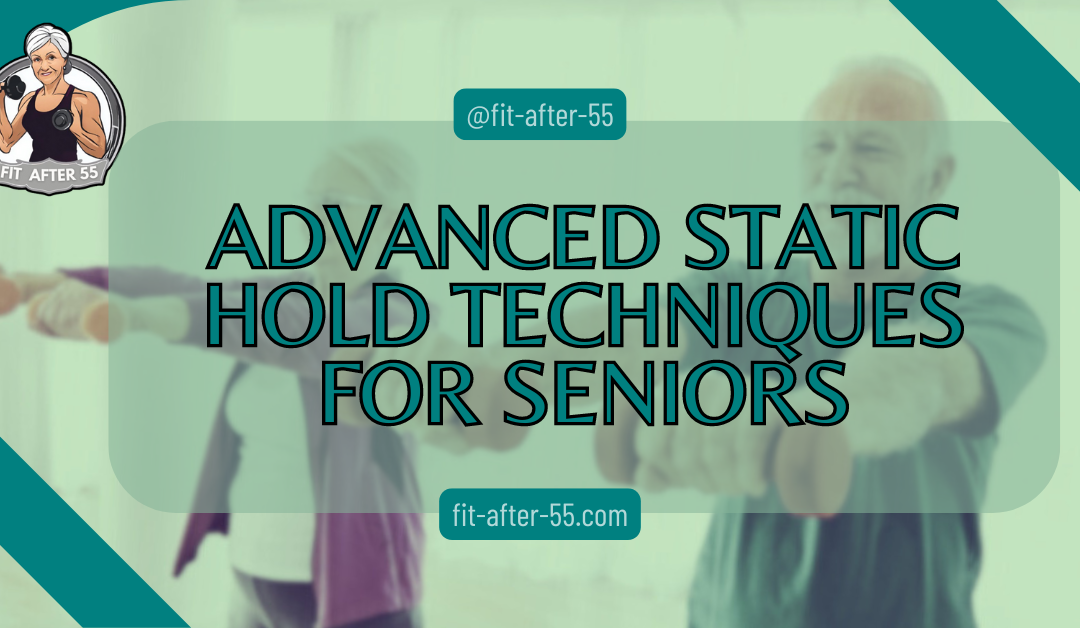Are you ready to take your fitness journey to the next level with Advanced Static Hold Techniques for Seniors? These powerful exercises build strength, stability, and confidence—without intense, high-impact workouts. Whether you want to enhance your balance, prevent falls, or stay strong and active, these exercises can make a real difference. In this article, we’ll guide you through expert tips and techniques tailored specifically for seniors, helping you safely challenge your muscles and unlock new levels of physical resilience. Keep reading to discover how these simple yet effective moves can transform your fitness routine and boost your overall well-being.
Advanced Static Hold Techniques for Seniors: Boosting Strength and Balance
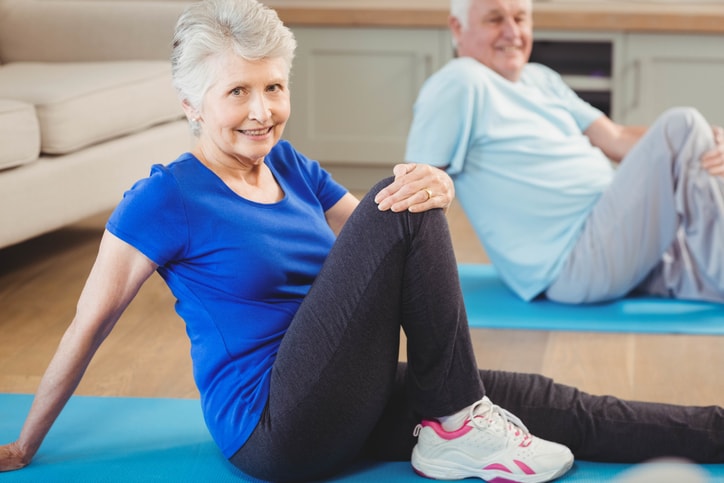
Static hold exercises can greatly benefit seniors by improving strength, balance, and stability. These techniques involve holding a position for a set time without moving, which helps build endurance and core strength. Static holds can enhance everyday activities like standing up from a chair or walking steadily.
You can start with simple exercises like wall sits or planks, then progress to more challenging advanced static hold techniques for seniors as your strength improves. It’s important to start slowly and listen to your body. Always consult with a doctor or physical therapist before beginning any new exercise routine.
Incorporating static holds into your fitness routine can boost your confidence and reduce the risk of falls. These exercises can be done at home with minimal equipment, making them accessible and convenient for seniors of all fitness levels.
Key Takeaways
- Static hold exercises improve strength, balance, and stability by maintaining a fixed position. They benefit everyday activities and reduce fall risk.
- Begin with basic static holds like wall sits and planks, then advance as you build strength. Always listen to your body and consult with a healthcare professional.
- Ensure proper form, warm up adequately, and balance exercise with rest to prevent injuries and enhance effectiveness.
- Static holds are joint-friendly and can be modified for various mobility levels, making them accessible for seniors with different fitness needs.
- Integrate static holds into routine activities, such as brushing teeth or watching TV, to make strength-building a natural part of your day.
Benefits of Static Hold Exercises for Seniors
Static hold exercises can be great for older adults. These exercises involve holding a position without moving. They help build strength and stability. You can do them with minimal equipment. This makes them perfect for home workouts. Static holds can improve your balance. This is crucial as you age. Better balance means fewer falls and injuries.
These advanced static hold techniques for seniors are gentle on your joints. You don’t need to move, so your body has less stress, which is especially beneficial if you have joint pain or arthritis. Static holds can also boost your endurance by teaching your muscles to work for longer periods, making everyday tasks easier. Additionally, you can easily adjust these static holds to your fitness level. Start with short holds and gradually increase the time, allowing you to progress safely.
Static holds may help with posture. Many hold target core muscles. A stronger core can lead to better posture and less back pain. These exercises can be done anywhere. You can do wall sits while watching TV or planks during commercial breaks. Static holds may improve your bone density. This is important for preventing osteoporosis. Stronger bones mean a lower risk of fractures.
Safety Guidelines and Precautions
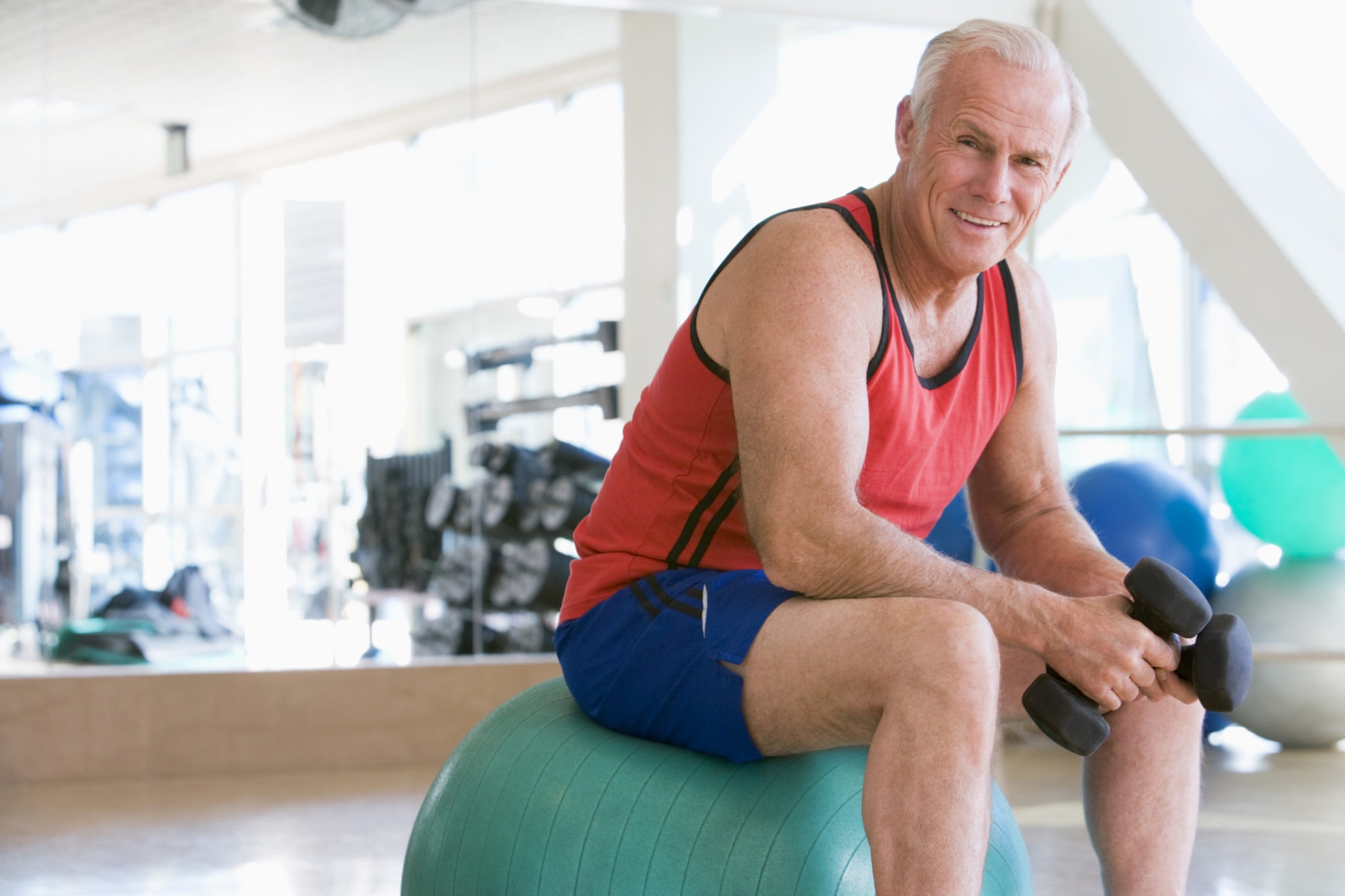
Advanced static hold techniques for seniors can build strength and stability, but safety comes first. Follow these key guidelines to prevent injuries and get the most benefit from your workouts.
Understanding Your Limits
Know your physical capabilities before starting static holds. Talk to your doctor about any health concerns. Start with shorter hold times, like 10-15 seconds. Gradually increase as you get stronger. Listen to your body. Stop if you feel pain or extreme discomfort. Feeling some muscle fatigue is normal, but sharp pains are a red flag.
Pay attention to your breathing. Try to breathe normally during holds. If you can’t, the exercise may be too intense. Keep a log of your workouts. Note how long you held each position and how you felt after. This helps track progress and spot potential issues.
Proper Warm-Up Techniques
Always warm up before static holds. This prepares your muscles and joints for exercise. Start with 5-10 minutes of light cardio, like walking or marching in place. Do some dynamic stretches. Arm circles, leg swings, and gentle twists are good options. Hold each stretch for just a few seconds. Try more accessible versions of the holds you plan to do. For example, do a wall push-up before attempting a plank hold.
Maintaining Proper Form
- Good form is crucial for safety and effectiveness. Use a mirror or ask someone to check your posture during holds.
- Keep your spine neutral. Don’t arch your back or let your hips sag.
- Engage your core muscles. This helps protect your back and improves stability.
- For standing holds, keep your feet hip-width apart. This gives you a stable base.
- If balance is an issue, do seated or lying exercises. You can still get benefits without risking falls.
Balancing Intensity and Rest
Rest is just as important as the exercise itself. Take breaks between holds. Start with rest periods equal to your hold times. Don’t do static holds every day. Aim for 2-3 times a week with rest days in between. This gives your muscles time to recover.
Stay hydrated. Drink water before, during, and after your workout. Mix static holds with other types of exercise. This prevents overuse injuries and keeps your routine interesting. If you feel unusually tired or sore, take an extra rest day. Your body needs time to heal and get stronger.
Fundamental Static Holds
Static holds are exercises where you maintain a fixed position without moving. They help build strength and stability. Advanced static hold techniques for seniors can be adapted to improve balance and muscle endurance.
Isometric Wall Sit
The wall sit is a great lower body exercise for seniors. Find a smooth wall and lean against it. Slowly slide down until your thighs are parallel to the ground. Keep your back flat against the wall. Your knees should be at a 90-degree angle. Hold this position for 15-30 seconds.
As you get stronger, try to hold it longer. Remember to breathe normally during the hold. If you feel knee pain, slide up the wall a bit. This exercise strengthens your quads, hamstrings, and core muscles.
Standing Leg Hold
This exercise improves balance and leg strength. Stand near a chair or wall for support. Lift one foot off the ground, bending your knee. Hold this position for 10-15 seconds. Lower your foot and repeat with the other leg. Try to keep your body straight and avoid leaning.
As you get better, try to hold for longer. You can also lift your foot higher. This exercise works your standing leg and core muscles. Always listen to your body. If you feel unsteady, use the chair or wall for support.
Plank Variations
Planks are great for core strength. Modified planks are safer and easier for seniors. Start with a wall plank. Stand arm’s length from a wall. Lean forward and place your hands on the wall. Keep your body straight from head to heels.
Hold for 15-30 seconds. As you get stronger, try a countertop plank. Use the same form, but place your hands on a countertop. For more challenges, try a knee plank on the floor. Get on your hands and knees. Keep your back straight and hold for 15-30 seconds.
Arm and Shoulder Endurance Holds
These holds build upper body strength. Start with a wall push-up hold. Stand facing a wall, arm’s length away. Place your hands on the wall at shoulder height. Lean in slightly, keeping your body straight. Hold this position for 15-30 seconds. This works your chest, arms, and shoulders.
For a shoulder hold, stand with your arms at your sides. Raise them out to the sides until they’re parallel to the ground. Hold for 10-15 seconds. As you get stronger, try holding light weights during these exercises. Always use proper form to avoid injury.
Equipment Aided Holds
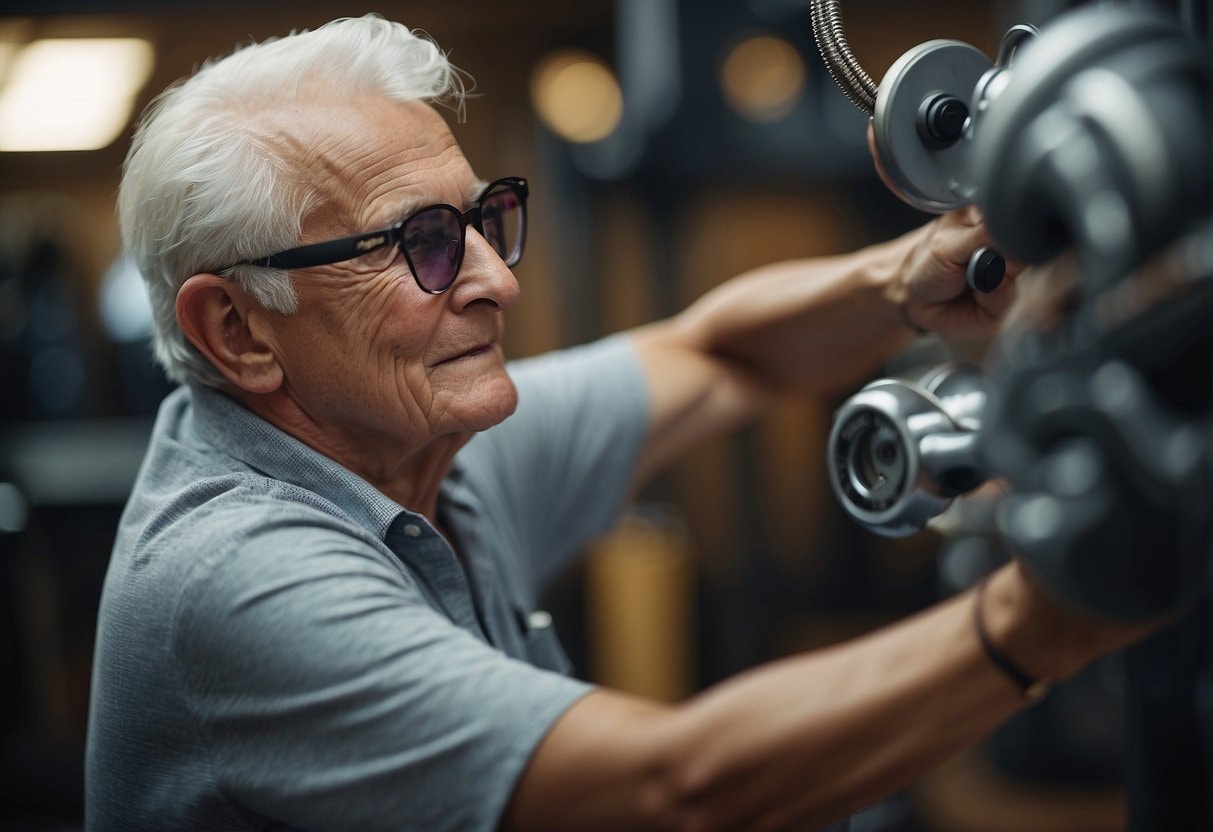
Simple equipment can enhance static holds to boost strength and stability. These tools allow seniors to perform holds safely while targeting specific muscle groups and improving balance.
Chair-Based Holds
Chair-based holds offer a stable base for seniors to perform static exercises. Start with a chair-hold squat. Stand in front of a chair with your feet shoulder-width apart. Lower yourself until you’re almost sitting, then hold the position. Aim for 10-30 seconds. Try wall slides next. Lean against a wall with your back flat. Slowly slide down until your thighs are parallel to the ground. Hold this position for 10-30 seconds.
For the upper body, do a chair plank. Place your hands on the seat of a sturdy chair. Step back until your body forms a straight line. Hold for 10-30 seconds. These chair-based exercises help build core strength and leg muscles without putting too much stress on your joints.
Using Resistance Bands
Resistance bands add challenge to advanced static hold techniques for seniors. Loop the band around a sturdy object at chest height for a chest hold. Grasp the ends and step back until there’s tension. Hold your arms out straight for 10-30 seconds. Try a band pull-apart hold. Hold the band in front of you with straight arms. Pull it apart until your arms form a T-shape. Hold for 10-30 seconds.
For legs, loop the band around your thighs just above your knees. Step into a squat position and hold, pushing your knees out against the band’s resistance. These exercises improve muscle endurance and joint stability. Start with light resistance and increase as you get stronger.
Balance Ball Exercises
Balance balls, also called stability balls, add an element of instability to static holds. This challenges your core and improves balance. Start with a seated hold. Sit on the ball with your feet flat on the floor. Lift one foot slightly off the ground and hold for 10-30 seconds. Switch feet and repeat. Progress to a wall squat with the ball.
Place the ball between your lower back and a wall. Slowly lower into a squat position and hold for 10-30 seconds. For a more advanced move, try a plank hold. Place your forearms on the ball and extend your legs behind you. Hold this position for 10-30 seconds. Always have a sturdy object nearby to grab if you lose balance. These exercises boost core strength and stability.
Light Hand Weight Holds
Light hand weights can add intensity to static holds. Start with a front raise hold. Hold a lightweight in each hand at your sides. Raise your arms straight out in front to shoulder height and hold for 10-30 seconds. Try a lateral raise hold next. Raise your arms out to the sides to shoulder height and hold. This targets your shoulder muscles.
For the lower body, do a goblet squat hold. Hold one weight with both hands close to your chest. Lower into a squat position and hold for 10-30 seconds. Begin with very light weights, even 1-2 pounds. Focus on proper form rather than weight. These holds build strength and endurance in targeted muscle groups.
Here’s another video on the best at-home exercise equipment for seniors.
By: All Strong Fitness
Progressive Training Techniques
Advanced static hold techniques for seniors can make static holds more challenging over time. These methods help seniors build strength and stability safely. They also add variety to workouts and keep exercises interesting.
Incremental Duration Increases
Start with short hold times and slowly add seconds. Aim to hold each position for 10-15 seconds at first. Each week, try to increase the time by 5 seconds. Keep track of your progress in a notebook or app. For example:
- Week 1: 15-second wall sit
- Week 2: 20-second wall sit
- Week 3: 25-second wall sit
Listen to your body. If you feel pain, go back to a shorter time. The goal is steady progress, pushing slowly.
Integrating Movement
Add small movements to static holds to increase difficulty. This helps work more muscles and improves balance. Try these:
- During a plank, lift one foot off the ground for 3 seconds, then switch.
- In a wall sit, extend one leg straight out for 5 seconds, then return and switch.
- While holding a chair squat, do small arm circles.
Start with 2-3 repetitions of each movement. As you get stronger, increase to 5-8 reps.
Variations for Strength Building
Change your position slightly to target different muscles. This builds overall strength and prevents boredom. Wall sit variations:
- Standard: Back against the wall, knees at 90 degrees
- Wide stance: Feet wider than hip-width
- Single leg: One foot flat, other foot raised
Plank variations:
- Full Plank: On hands or forearms
- Side Plank: On one forearm, body sideways
- Incline Plank: Hands on a chair or bench
Try a new variation each week. This keeps your muscles guessing and growing stronger.
Partner-Assisted Exercises
Working with a partner can make static holds safer and more fun. It also adds a social element to your workout. Try these partner exercises:
- Back-to-back Wall Sit: Sit against each other instead of a wall.
- Hand-held Plank: Face each other in the plank position, holding hands for support.
- Assisted Single-leg Stand: Stand on one leg while holding your partner’s hand for balance.
Always communicate with your partner. Tell them if you need to stop or adjust. Start with 10-15 second holds and increase together.
Did You Know?
Seniors should follow specific guidelines when stretching to improve flexibility. For best results, they should hold each stretch for 30 to 60 seconds and repeat it three times. They should avoid bouncing or jerking movements and stretch only to the point of mild tension, not pain.
Adapting Holds for Mobility Issues

Static holds can be modified to fit different mobility levels. These adaptations, including advanced static hold techniques for seniors, allow them to enjoy the benefits of holds safely and comfortably. Proper adjustments and support make these techniques accessible for those with limited movement.
Chair and Seated Modifications
You can do many static holds while sitting. A chair provides stability for exercises like seated planks. Place your hands on the chair seat and extend your legs. Keep your body straight and hold. For arm holds, sit tall and extend your arms out to the sides. Hold this position as long as you can.
You can also do shoulder shrugs while seated. Lift your shoulders towards your ears and hold. Leg lifts work well in a chair, too. Sit up straight and lift one leg parallel to the floor. Hold for 10-30 seconds, then switch legs.
Using Supportive Devices
Supportive devices make it safer and more effective. A wall is great for balance during standing holds. Try wall sits, or wall pushes to build strength. Resistance bands add challenge to seated holds. Loop a band around your feet for arm curls.
Hold the contracted position for 10-30 seconds. Foam rollers help with balance and core work. Sit on a roller and lift your feet off the ground. Hold this position to engage your core muscles.
Low-Impact Holds
Low-impact holds put less stress on your joints. Try a hollow hold on your back. Lift your arms and legs slightly off the floor and hold. Side-lying leg lifts are gentle on the hips. Lie on your side and lift your top leg. Hold for 10-30 seconds, then switch sides. For the upper body, do doorway chest stretches. Place your arms on either side of a doorway and lean forward slightly. Hold this stretch for 15-30 seconds.
Guided Static Hold Sessions
Guided sessions ensure you do it correctly and safely. Many senior centers offer classes focused on static exercises. These group sessions provide motivation and proper form checks. You can also find guided videos online. Look for senior-specific hold workouts.
These often include modifications for different ability levels. Consider working with a physical therapist. They can create a personalized hold routine based on your mobility needs. A therapist will teach you how to progress safely as you get stronger.
Mind-Body Connection in Static Holds
Static holds offer a unique opportunity to blend physical exertion with mental focus. By integrating breathing, visualization, and mindfulness, you can enhance the effectiveness of your advanced static hold techniques for seniors. This approach not only improves strength but also supports mental clarity.
Breathing Techniques
Proper breathing is key to successful static holds. Focus on slow, deep breaths to help maintain stability and reduce tension. Inhale through your nose for four counts, then exhale through your mouth for six counts. This technique, diaphragmatic breathing, can help you stay calm and centered during challenging holds.
Try to match your breath to the duration of your hold. For example, if you’re doing a 30-second wall sit, aim for 3-4 full breath cycles during that time. Remember to keep your breath steady and avoid holding it, which can increase blood pressure and muscle tension.
Mental Focus and Visualization
Your mind plays a crucial role in static holds. Visualize your muscles working and becoming more assertive as you hold each position. Picture yourself as a sturdy tree with deep roots, unmovable and grounded. Use positive self-talk to push through challenging moments.
Repeat phrases like “I am strong” or “I can hold this” in your mind. Try to focus on a specific point in front of you to help maintain balance and concentration. This can be especially helpful for exercises like the high plank.
Mindfulness and Static Holds
Practicing mindfulness during static holds can enhance your mind-body connection. Pay attention to how each muscle feels as you hold the position. Notice any areas of tension or discomfort without judgment.
Be present in the moment, letting go of distracting thoughts. If your mind wanders, gently bring your focus back to your body and breath. Try a body scan technique. Start at your toes and mentally work your way up, noticing each part of your body as you hold the position.
Combining Static Holds with Meditation
Integrating meditation with static holds can create a powerful mind-body practice. Before you hold:
- Take a few moments to sit quietly and center yourself.
- During the hold, use a simple mantra or affirmation.
- Repeat it silently with each breath to maintain focus and calm.
After your static hold session, take a few minutes to meditate. Reflect on the sensations in your body and the mental strength you demonstrated. You can also try alternating short static holds with brief meditation periods. This can help you build both physical and mental endurance over time.
Incorporating Static Holds into Daily Life
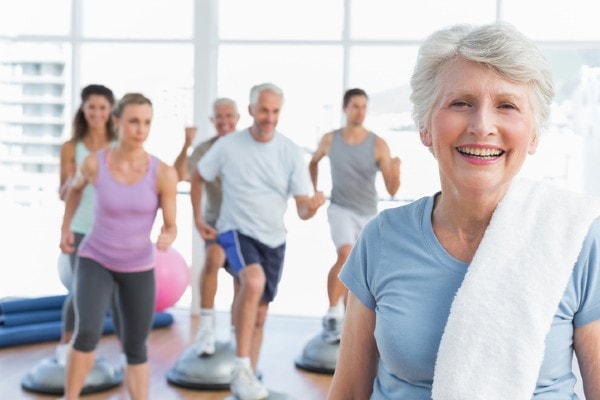
Static holds, including advanced static hold techniques for seniors, can seamlessly integrate into your everyday activities. Making small adjustments to your routine can improve strength and stability without setting aside extra time for exercise.
Static Holds While Performing Daily Tasks
Look for opportunities to add static holds to tasks you already do. While brushing your teeth, try standing on one leg for 30 seconds. This improves balance and works your core muscles. When carrying groceries, pause for 10-15 seconds before setting them down. This turns a simple chore into a forearm and grip strength exercise.
While watching TV, practice wall sits during commercial breaks. Lean against a wall with knees bent at 90 degrees. Hold for 20-30 seconds. When cooking, do countertop push-ups. Place hands on the edge of a sturdy counter and lean forward. Hold for 15-20 seconds to work your chest and arms.
Creating a Routine
Set specific times for static hold exercises throughout your day. This helps form lasting habits.
Morning routine:
- 30-second plank while waiting for coffee
- 20-second doorway chest stretch before getting dressed
Afternoon routine:
- The 15-second overhead arm holds during work breaks
- 25-second chair pose while eating lunch
Evening routine:
- 30-second wall sit while brushing teeth
- 20-second calf raises while doing dishes
Start with shorter hold times and gradually increase as you get stronger. Aim for 2-3 static holds per day to begin.
Maintaining Consistency
- Consistency is key to seeing results from static holds. Use reminders to stay on track.
- Set alarms on your phone for designated static hold times. Place sticky notes in key areas as visual cues.
- Track your progress in a journal or app. Seeing improvements can boost motivation.
- Find an accountability partner. Share your static hold goals with a friend or family member. Check-in regularly to stay motivated.
- Be patient with yourself. It takes time to form new habits. If you miss a day, don’t get discouraged. Start again the next day.
Tracking Progress
- Monitoring your static hold performance helps you see improvements over time. This can motivate you to keep going.
- Use a timer to track how long you can hold each position. Record your times in a notebook or fitness app.
- Take progress photos every few weeks. Visual changes can be encouraging, even if the numbers don’t always show it.
- Set small, achievable goals. For example, aim to increase your wall sit time by 5 seconds each week.
- Celebrate your successes, no matter how small. Each improvement is a step towards better strength and stability.
- Remember, progress isn’t always linear. Some days, you might hold positions longer than others. Focus on the overall trend rather than day-to-day fluctuations.
Nutritional Considerations for Strength Training
Good nutrition is key for seniors doing strength training, including advanced static hold techniques for seniors. Your body needs the right fuel to build and repair muscles. Protein is crucial. Aim for about 1.2 to 1.6 grams per kilogram of body weight daily. Good sources include:
- Lean meats
- Fish
- Eggs
- Dairy products
- Beans and legumes
Carbohydrates are important, too. They give you energy for workouts. Choose whole grains, fruits, and vegetables. Remember about healthy fats. They help with hormone production. Add nuts, seeds, and avocados to your diet.
Stay hydrated. Drink water before, during, and after exercise. This helps your muscles work better. Calcium and vitamin D are vital for bone health. Dairy products, leafy greens, and fortified foods are good choices.
Timing matters. Try to eat a meal with protein and carbs within an hour after your workout. This helps with muscle recovery. Remember to eat enough calories. Strength training burns energy, so you should eat more than usual. Talk to your doctor or a dietitian. They can help you create a meal plan that fits your needs and health status.
Hydration and Recovery in Static Training

Staying hydrated is key when doing static holds. Drink water before, during, and after your workout. Aim for 8-10 glasses of water daily. Clean water is best for hydration. You can also drink herbal tea or low-fat milk. Avoid alcohol, as it can make you lose fluids.
After static training, your muscles need time to recover. Incorporating advanced static hold techniques for seniors can enhance this recovery process. Get enough sleep each night. This helps your body repair and grow stronger. Eat protein-rich foods to help your muscles recover. Good choices include:
- Lean meats
- Fish
- Eggs
- Greek yogurt
- Beans
Stretch gently after your workout. This can help reduce muscle soreness and improve flexibility. Listen to your body. If you feel very sore, take a rest day. To stay active, you can do light activities like walking or swimming.
Remember to breathe during static holds. This helps your muscles get oxygen and can make the exercises feel easier. Consistency is important. Try to do static training 2-3 times a week. This gives your body time to recover between sessions.
Community and Social Aspects of Exercise
Exercise can be more fun and rewarding when done with others. Group activities offer seniors a chance to socialize while staying active. Incorporating advanced static hold techniques for seniors can further enhance the benefits of these exercises, promoting better strength and stability.
Many community centers provide exercise programs for older adults. These classes are often tailored to different fitness levels, making them suitable for everyone. Some popular group activities include:
- Walking clubs
- Water aerobics
- Dance lessons
- Yoga sessions
Joining a group can help you stay motivated. You’ll have friends to cheer you on and keep you accountable. Community calendars are useful for finding local exercise events. Check your neighborhood center or library for upcoming activities. Exercise buddies can make workouts more enjoyable.
Find a friend or family member to join you for regular walks or gym sessions. Online communities can also provide support. Many fitness apps have forums to connect with other seniors who share your goals. Remember, social interaction is good for your mental health, too. Combining exercise with socializing gives you a double benefit for your overall well-being.
Check out this additional video featuring the top 10 balance exercises for seniors to do at home.
By: Bob & Brad
Elevate Your Strength: Advanced Static Hold Techniques for Seniors to Enhance Stability and Balance
Advanced static hold techniques for seniors can offer significant benefits, including improved strength, stability, and balance. By incorporating exercises such as wall sits, planks and standing leg holds, seniors can enhance their core strength and endurance, making everyday activities easier and reducing the risk of falls. These advanced static hold techniques are gentle on the joints and can be performed with minimal equipment, making them accessible for home workouts. It’s crucial to start slowly, consult with a healthcare professional, and gradually increase the difficulty of these exercises to ensure safety and effectiveness.
In addition to physical benefits, integrating static holds into daily routines can help seniors maintain a consistent exercise practice. Simple adaptations, such as doing wall sits during TV commercial breaks or practicing seated holds while cooking, allow seniors to seamlessly incorporate strength training into their daily lives. By tracking progress, maintaining good form, and ensuring proper hydration and nutrition, seniors can effectively build strength and stability while enjoying regular exercise’s social and mental health benefits.
Frequently Asked Questions
What Are the Safest Static Hold Techniques for Improving Balance in Seniors?
Stance hold practice is one of the safest static hold techniques for seniors. This involves standing still with feet together or in a heel-to-toe position. Wall sits are another safe option. You lean against a wall and slowly lower yourself as if sitting in a chair.
How Can Seniors Effectively Practice Static Holds at Home?
Use sturdy furniture or countertops for support when starting out. Begin with short hold times and gradually increase as you get stronger. Always have a chair nearby in case you need to sit down. Wear comfortable, non-slip shoes to prevent accidents.
Which Balance Exercises Are Most Beneficial for Seniors According to Recent Studies?
Single-leg stands have shown great benefits for seniors. Start by holding onto a chair and lift one foot slightly off the ground. Weight shift drills are also highly effective. These involve shifting your weight from one foot to the other while standing.
Embrace Wellness, Feel Great: Join the Fit After 55 Community!
Dive into fitness inspiration with Fit After 55!
Our website (https://www.vitalityseniorliving.com/resources_for_senior/staying-fit-at-55/) is filled with valuable content, expert guidance, and product reviews tailored for seniors. Connect with fellow enthusiasts who are passionate about health and fitness on our Facebook page (https://www.facebook.com/fitafter50dotcom/).
Let’s embark on this fitness journey together and demonstrate that age is merely a number!

